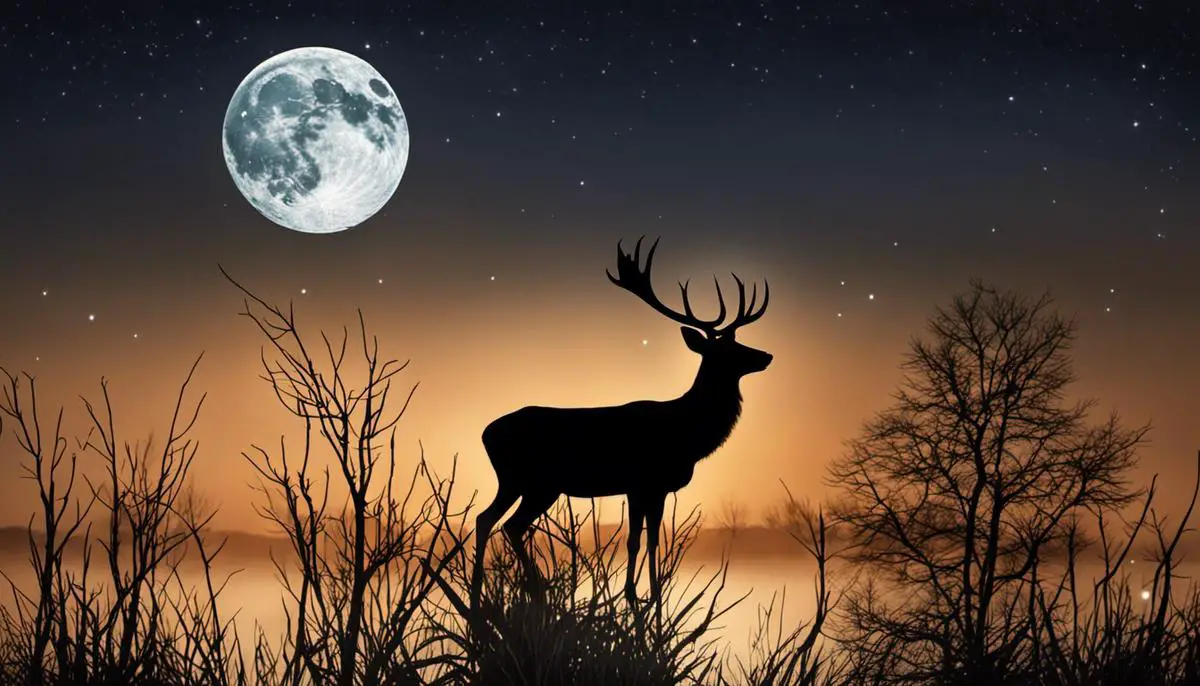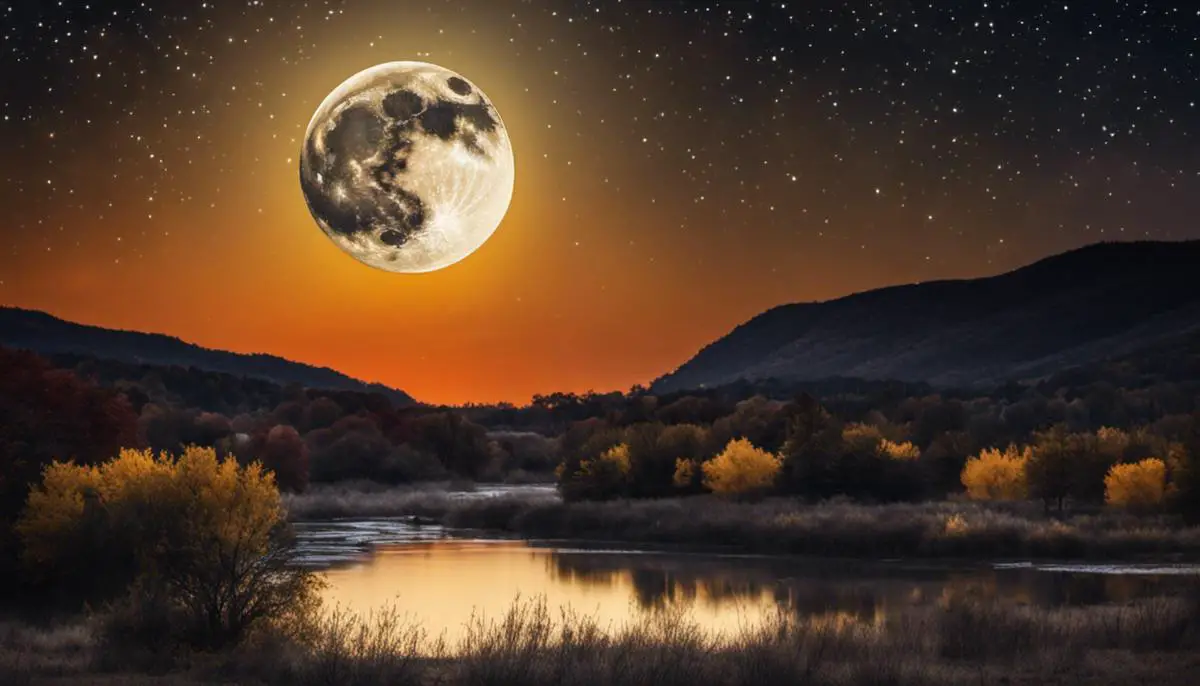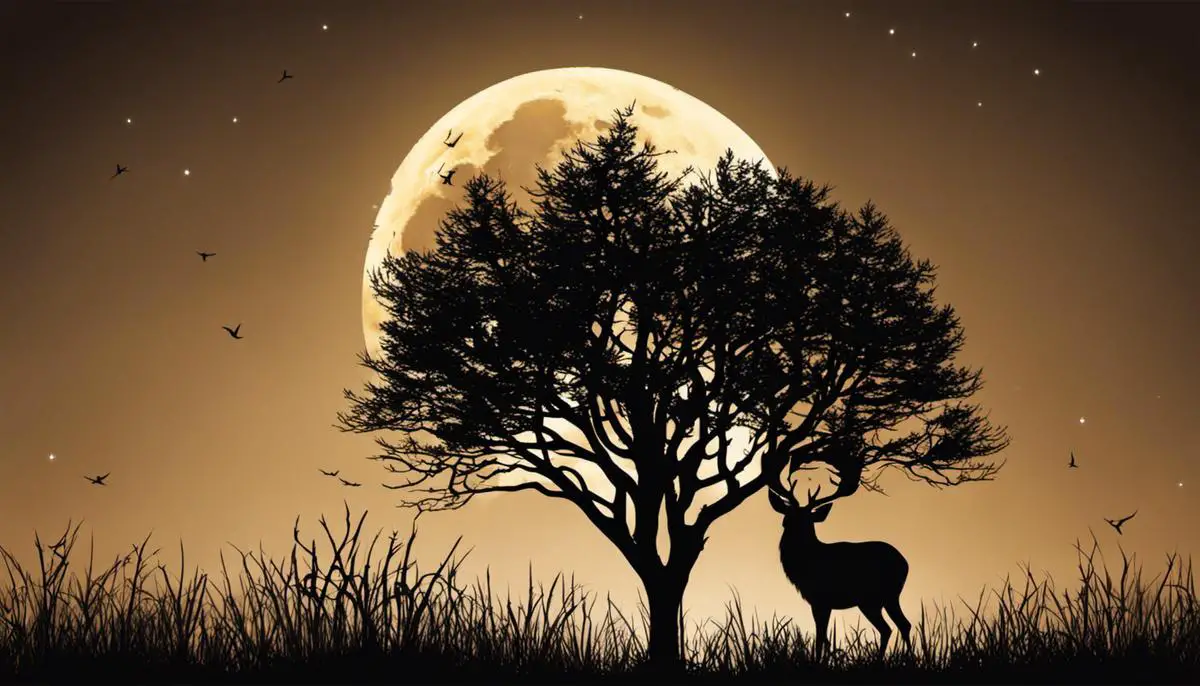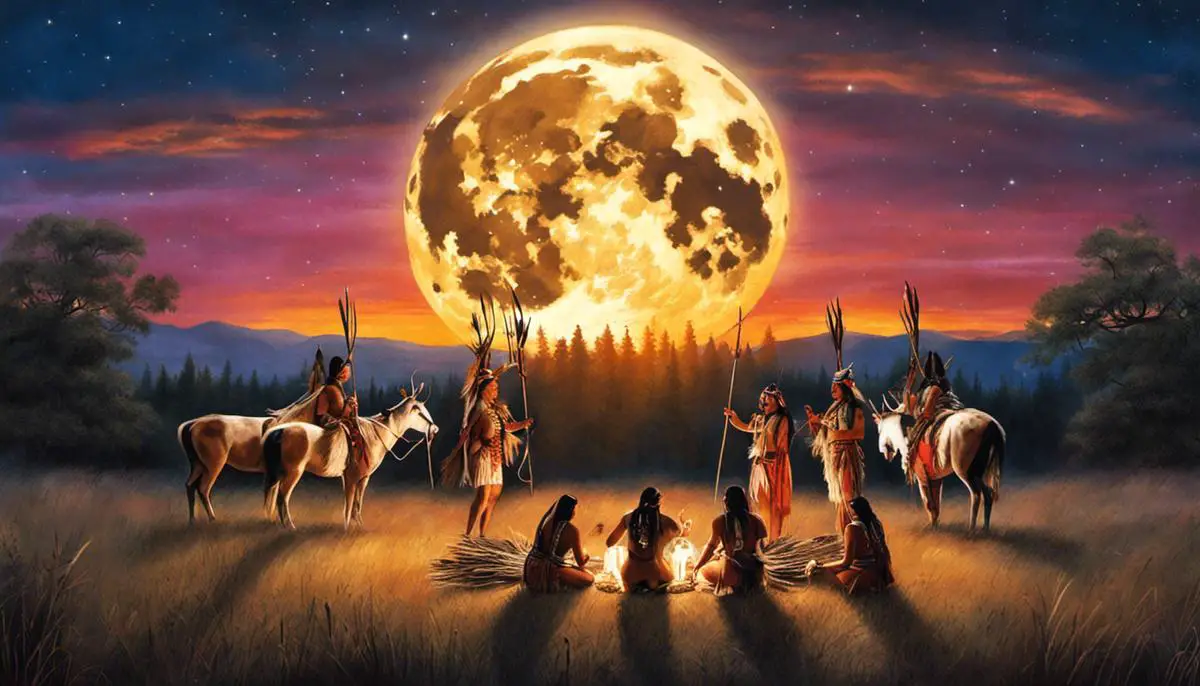In the vast, starlit night sky, a recurring spectacle captures our collective fascination – the Full Moon. Each full moon throughout the year carries its unique folklore, symbolism, and cultural significance. This is particularly true for the ‘Buck Moon’, a term deeply rooted in early Native American cultures, reflecting their profound connection with nature. This essay seeks to explore the diverse elements associated with the Buck Moon ranging from its origins and significance to its influence on wildlife behavior and its spiritual interpretations.
Origins and Significance of the Buck Moon
The Root and Significance of the Buck Moon
Native American tribes across what is now known as the United States initially utilized Full Moon names. To these tribes, the moon’s cycles were of great importance as they aided their comprehension of time and seasons, being the primitive method they employed in tracking time. The naming of each Full Moon was typically linked to the peculiar activities of plants, animals, or the climate during that specific lunar phase.
One of these coined terms is the Buck Moon, a name given to the Full Moon that appears in July. The moniker “Buck Moon” comes from the observation that during the summer months, particularly around July, male deer or bucks, initiate the regrowth of their antlers. This re-emergence of antlers clothed in velvety fur, a prominent symbol of strong male energy, is distinct to this season and is observed in coincidence with this specific Full Moon.
For various tribes, the Buck Moon signifies not just the phase of rebirth and revival visible in the bucks, but also a period for readiness and resource accumulation. Summer would typically be a period of plentifulness with abundant summer forages. Therefore, the Buck Moon carried an essential ceremonial and life-cycle implication underlining the connection between animal behaviors and moon cycles, guiding tribes’ decisions on hunting, gathering, and other survival activities.
This symbol of the Buck extended beyond physical sightings and tied deeply into tribal myths and religious practices. Bucks are often revered as emblems of wealth, good fortune, stability, and power in Native American traditions, therefore the Buck Moon represented a time of rejoicing and gratefulness for the bounty they believed the cosmos was bestowing upon them.
Today, the term “Buck Moon” continues to be popular and is frequently mentioned along with modern moon names. In this modern era, while most people are less dependent on survival activities rigidly tied to the moon’s cycles, the full moon continues to be a time for reflection. The Buck Moon serves as a reminder of the power, growth, and wealth, which this period has historically signified.

Astronomical Aspects of the Full Moon Buck Moon
The Astronomical Observation of the Full Moon Buck Moon
The Full Moon Buck Moon is a celestial event that happens annually. Its name is inspired by the behavior of buck deer, who typically sport new antlers during this mid-summer period. This cosmic event is also sometimes referred to as the Thunder Moon, referring to the frequently occurring thunderstorms during this season.
Phase and Timing
Full moons occur when the Earth is located between the Sun and the Moon, causing the lunar surface to be fully illuminated. The Full Moon Buck Moon usually appears in July, although its specific date can vary each year, falling either towards the end of June or the beginning of August.
Ideal Conditions for Viewing
The optimal conditions for viewing this full moon are when the sky is clear, with minimal light pollution. Urban environments with large amounts of artificial light can significantly reduce visibility, so it is ideal to seek out a rural or semi-rural location. As with most celestial events, the best viewing times are typically after midnight and before dawn.
Celestial Position and Neighbors
The Full Moon Buck Moon can be found in the constellation Capricornus, the “sea goat,” during its full phase. This constellation neighbors Aquarius to the east and Sagittarius to the west. It is situated relatively low in the southern sky, which makes it appear particularly large due to the “moon illusion,” a pervasive optical illusion that tricks the brain into perceiving the moon as larger when it is near the horizon.
Unusual Visual Characteristics
While the Buck Moon is a type of full moon and therefore shares many common features with other full moons, it does have a few unusual visual characteristics to note. For starters, it may take on a slightly yellow, orange, or red hue. This is caused by the Earth’s atmosphere acting like a lens, scattering shorter-wavelength light, green through violet, to a much greater degree than longer-wavelength light, red through yellow.
The Full Moon Buck Moon also often displays a high degree of brightness, more so than many other full moons throughout the year. This is thanks in part to its proximity to the summer solstice, which typically occurs just a few weeks prior, and the high overhead Sun this time of year tends to make the full moon unusually high and bright as well. Additionally, the planet Mars is often visible next to the moon during this period, adding a distinct red point of light to the spectacle.
Introduction to the Full Moon Buck Moon
Commonly known as the Full Moon Buck Moon, this captivating astronomical event signifies a beautiful harmony between earth and the heavens. It accentuates nature’s infallible cycle governed by lunar influences, such as the shedding of a new set of antlers by bucks. Besides its appeal to those interested in astronomy, it’s also a symbol of life’s abundance during the height of summer.

Spiritual and Symbolic Interpretations of Buck Moon
Understanding the Buck Moon
Referred to as the Full Buck Moon, this celestial event refers to the full moon that occurs during July. The name “Buck Moon” stems from Native American traditions of christening each full moon according to seasonal and natural occurrences. July is notable as the period when a buck’s antlers reach their fullest growth, ready for the inevitable duels for potential mates come fall.
Spiritual Significance in Native American Cultures
Among several Native American tribes, the Buck Moon is a symbol of potency, strength, and the power of life’s renewing cycles. The Buck Moon signifies the peak of the summer season and the abundant growth that it brings. It serves as a reminder of creation and the successful completion of goals. It is also seen as a time of reflection, where individuals are encouraged to reflect on their own growth and path in life.
Astrological Interpretations
In Western astrology, full moons are generally viewed as a period of illumination, romance, and creativity. They signal a time to harvest and reap the benefits of the seeds sown in prior months. Therefore, the Buck Moon, representative of the peak of summer, likewise symbolizes the height of growth and progress in an individual’s personal life. The full moon is believed to amplify emotions, leading to deep introspection and self-analysis.
Symbolic Interpretation in Other Cultures
In other cultures, the Full Buck Moon carries varied interpretations. For example, in some African traditions, a full moon represents the height of ancestral power, promoting a deeper spiritual connection with forebears. In countenance with the fertility displayed by the buck, the Full Buck Moon is believed to hold a powerful fertility energy.
In some East Asian cultures, the full moon is often symbolic of family unity and togetherness. Hence, the Buck Moon can be perceived as a time to strengthen familial relationships and spend more time with loved ones.
Spiritual Energy of the Full Buck Moon
The spiritual energy of the Buck Moon is believed to be very robust and masculine. It encourages self-reflection, emotional exploration, and deep understanding. This time is optimal for personal growth, manifesting dreams, and achieving personal balance. The Buck Moon is also seen as providing a soothing effect, allowing individuals to gather their strength and heal during this full moon period.
Furthermore, the Buck Moon can be a powerful time for meditation. Focused intention under this full moon can lead to personal breakthroughs and increased self-awareness. With its emphasis on fertility and growth, it can also be considered a potent time for manifesting desires and dreams into reality.
Overview
In essence, the Full Buck Moon unites varied interpretations across diverse cultures, but a consistent theme is that it invites a period of introspection and growth. As it symbolizes full bloom, power, and the completion of a cycle, it’s linked with the attainment of peak potential, and the use of this energy for personal and spiritual evolution.

Buck Moon and Wildlife Behavior
The Lore Behind the Buck Moon
The term, Full Buck Moon, takes its roots from Native American traditions of giving full moons unique names. This moon usually graces the skies in July and earned its name from the fact that during this period, the antlers of a buck (a male deer) have normally reached their maximum size. This term and the peculiar natural process it signifies is not restricted by geography but are observable worldwide wherever deer are an integral part of the eco-system.
The Lunar Phase and Wildlife Behavior
The lunar cycle has a significant influence on wildlife behavior. A full moon, like the Buck Moon, triggers specific activities in many wildlife species, particularly nocturnal ones. The additional light the full moon provides makes it easier for predators to hunt, and therefore influences feeding activities. Some studies also indicate that wildlife, especially marine species, engage in more mating behaviors during a full moon.
Buck Moon’s Impact on Deer Behavior
For deer, specifically bucks, the Full Buck Moon signifies an important time of year. It’s when their new antlers have typically finished growing and are fully formed, a process fueled by increased daylight in the summer months. Hence, it’s a critical period of physiological change.
However, there is minimal empirical data suggesting that the Buck Moon directly influences deer behavior. Deer are not predominantly nocturnal and thus are not as affected by the lunar cycle compared to some other species. Additionally, deer antler growth is primarily regulated by photoperiod, that is, the length of day, and not the lunar cycle.
Buck Moon, Breeding, and Migration Patterns
Regarding breeding patterns, the rut season (deer mating season) usually occurs in the fall, months after the Buck Moon. Hence, there isn’t a direct correlation.
As for migration patterns, deer movements align more tightly with seasonal changes—food availability and weather conditions—than they do with any particular lunar cycle. Improvements in satellite tracking technology have made it clear that while deer movements might increase during the nighttime with a full moon due to enhanced visibility, the effect is not profound enough to drive significant migratory behavior trends.
In conclusion
While the Buck Moon carries a significant cultural and folkloric meaning and represents important developmental stages in a buck’s life, scientific evidence for the Buck Moon causing any substantial shifts in deer behavior, migration or breeding patterns remains scarce. The changes in deer behavior around this time are more attributed to seasonal and daylight changes than the lunar phase.

After traversing through the historical imprints, astronomical nuances, spiritual insights, and natural impacts of the Buck Moon, one thing becomes clear – our lunar companion’s pervasive influence extends far beyond lighting up the night sky. It’s intertwined into the fabric of our cultures, ingrained in our folklore, and subtly echoes in the behavior of the wildlife around us. Full moons like the Buck Moon, therefore, reflect not only outer space’s astronomical wonder but the cultural richness and biodiversity of our own world too.
![]()
